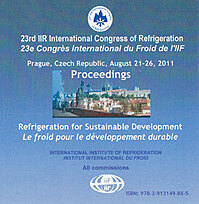
Résumé
We present non-traditional refrigeration circuit that has been prepared and developed for the particle detector cooling. Such unique applications require many additional technical demands compared to standard cooling circuits. Employed refrigerant must provide suitable performance within radioactive and magnetic fields; it should be chemically stable and moreover it should have dielectric performance to avoid damage of employed electronics in case of evaporator leakage. The special vapour cooling circuit capable to operate with fluorocarbon refrigerants (R218, R116, R610 or even with their mixtures), was designed for testing different elements of the final particle detectors’ cooling circuits e.g. heat exchangers, capillary tubes, evaporators and basic elements of the relevant cooling circuit control system. Successful implementation and use of the circuit is demonstrated via results obtained during commissioning runs with the Roman Pots (RP) detectors that are being installed and used within the TOTEM project at the LHC (Large Hadron Collider) at CERN.
Documents disponibles
Format PDF
Pages : 8 p.
Disponible
Prix public
20 €
Prix membre*
Gratuit
* meilleur tarif applicable selon le type d'adhésion (voir le détail des avantages des adhésions individuelles et collectives)
Détails
- Titre original : Versatile refrigeration circuit developed for the particle detector commissioning.
- Identifiant de la fiche : 30002194
- Langues : Anglais
- Source : Proceedings of the 23rd IIR International Congress of Refrigeration: Prague, Czech Republic, August 21-26, 2011. Overarching theme: Refrigeration for Sustainable Development.
- Date d'édition : 21/08/2011
Liens
Voir d'autres communications du même compte rendu (569)
Voir le compte rendu de la conférence
Indexation
-
Mechanical design of the barrel electromagnetic...
- Auteurs : ARETIO-ZARATE F., KARST P., ALEKSA M., CHALIFOUR M., BREMER J., NIKIFOROU N., SHAW A.
- Date : 07/04/2025
- Langues : Anglais
- Source : Cryogenics 2025. Proceedings of the 18th IIR International Conference on Cryogenics, Prague, Czech Republic, 7-11 April 2025.
- Formats : PDF
Voir la fiche
-
Two large 18 kW (equivalent capacity of 4.5 K) ...
- Auteurs : DAUGUET P., GISTAU-BAGUER G. M., BRIEND P.
- Date : 16/05/2000
- Langues : Anglais
- Source : Sixth conference on cryogenics and superconductivity. Proceedings (comprising papers and posters)./ Sixièmes Journées de cryogénie et de supraconductivité. Recueil des présentations orales et posters.
Voir la fiche
-
Réalisation et mise en service d'un refroidisse...
- Auteurs : WILD S., HOFMANN A., OELLRICH L. R.
- Date : 16/11/1994
- Langues : Allemand
- Source : DKV-Tagungsbericht 1994 Bonn.
Voir la fiche
-
Performance of a mixed refrigerant J-T refriger...
- Auteurs : GURUDATH NAYAK H., SRINIVASA MURTHY S., VENKATARATHNAM G.
- Date : 21/08/2007
- Langues : Anglais
- Source : ICR 2007. Refrigeration Creates the Future. Proceedings of the 22nd IIR International Congress of Refrigeration.
- Formats : PDF
Voir la fiche
-
The future of CO2 cooling in particle physics d...
- Auteurs : VERLAAT B., COLIJN A. P., POSTEMA H.
- Date : 21/08/2011
- Langues : Anglais
- Source : Proceedings of the 23rd IIR International Congress of Refrigeration: Prague, Czech Republic, August 21-26, 2011. Overarching theme: Refrigeration for Sustainable Development.
- Formats : PDF
Voir la fiche
